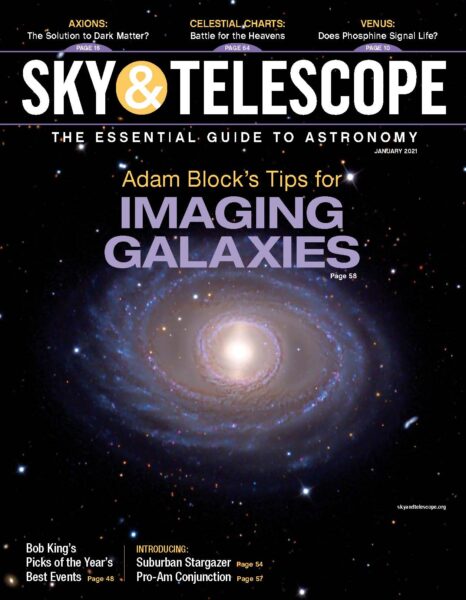
New Columns, Winter Galaxies, and Ice on the Moon
In the January 2021 issue of Sky & Telescope, we’re introducing three new columns: Evenings with the Stars, Suburban Stargazer, and Pro-Am Conjunction. Evenings with the Stars will focus on naked-eye stargazing, while Suburban Stargazer will help readers make the best out of light-polluted skies. Pro-Am Conjunction looks at the connections between amateur and professional astronomers, starting with a classic in every sense of the word: the century-old American Association for Variable Star Observers. After constellation-gazing, we’re ready to break out the big scopes and head out in search of dark skies. We hunt down some stunning winter galaxies and offer helpful tips for capturing their intricate details. While we gaze up at the light from our galaxy and from others, in this issue, we’re also seeing the dark side: From the ice hidden in permanently shadowed craters on the Moon to the tiny particles that might be the answer to dark matter, we’re taking a long hard look at the darkness and beginning to wonder what else it might be hiding.
FEATURE ARTICLES:
The search for an almost invisible and wholly hypothetical elementary particle is on!
By Benjamin Skuse
Head off the beaten path to expand your January observing list.
By Ted Forte
Tiny spacecraft are launching to tell us more about the water ice that lurks in shadowed craters on the Moon.
By Christopher Cokinos
Here are some tips to get the most out of your galaxy images.
By Adam Block
The story of one man’s attempt to recast the constellations of mythology with biblical figures.
By Michael Mendillo
Beyond the Printed Page:
Phosphine in the Clouds of Venus
Read about the discovery of a potential biosignature in Venus’s clouds.
American Association of Variable Star Observers
Participate in important ongoing astronomical research with the AAVSO.
Peruse Sky & Telescope Contributing Editor Steve Gottlieb’s observing notes on all 7,840 objects in the NGC catalog.
Amateur Astronomer Discovers a Large Asteroid
Learn about the kilometer-sized, potentially-hazardous near-Earth asteroid that was recently discovered by an amateur.
ALSO IN THIS ISSUE:
Winter’s best-known constellation is also its brightest.
By Fred Schaaf
A full year of observing enjoyment awaits.
By Bob King
This legendary phenomenon is a product of Earth’s atmosphere rather than the Red Planet’s.
By Thomas A. Dobbins
Even under bright city skies, the Bull contains celestial sights worth seeking.
By Ken Hewitt-White
Table of Contents
See what else January's issue has to offer.
 0
0

Comments
You must be logged in to post a comment.